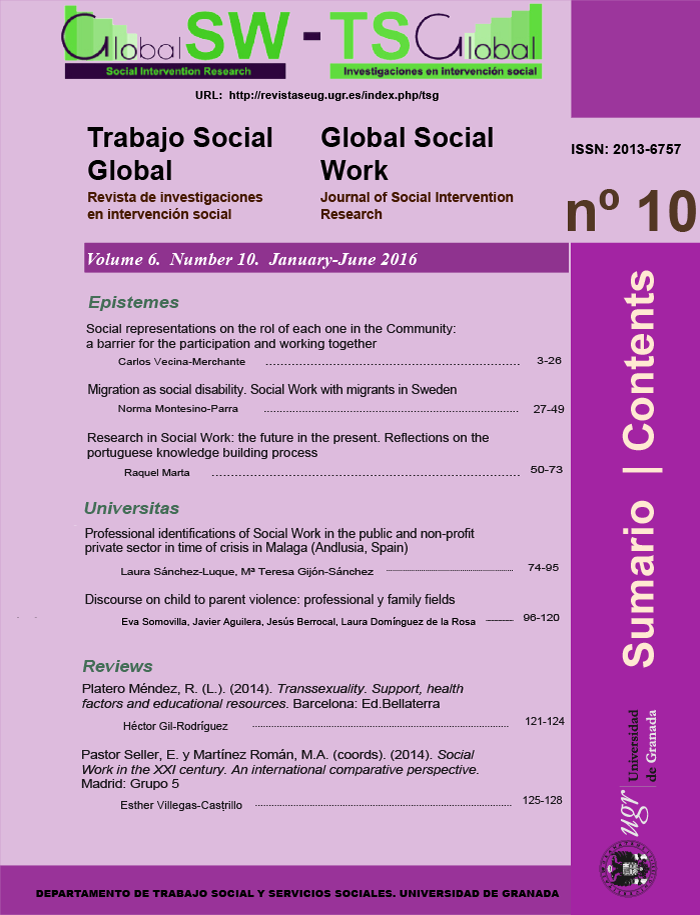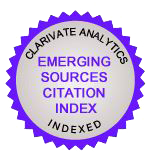Social Representations on the role of each one in the Community, a barrier for the participation and working together
DOI:
https://doi.org/10.30827/tsg-gsw.v6i10.3837Keywords:
Social representations, discourse, social capital, community intervention, social participationAbstract
We believe that social representations can be an important factor when considering the possible determinants in community action. Different members of the community (both, citizens and professionals) tend to cluster around their allies, by setting a discourse concerning his own role in the context and the role played by the rest of members. This may be a difficulty for joint action and for integration of the various initiatives that are launched, whereas the lack of communication, or an inadequate or biased communication, can be a handicap for the configuration of social capital and cohesion. This paper refers to some theoretical principles related to above concepts and the role played by each actor in the community, in addition to analyzing the speeches generated in a participatory research conducted by author in 2011, which is now useful to analyze what is behind the social representations of each one and the content that gives them consistency.
Downloads
References
Alsinet, J.; Riba, C.; Ribera, M.; Subirats, J. (2003). Més enllà de l'escola: Transformacions socials i noves dinàmiques educatives i professionals. Barcelona: Fundació Jaume Bofill.
Barbero, J.M. y Cortés, F. (2006). Trabajo comunitario, organización y desarrollo social. Madrid: Alianza Editorial.
Berger, P. y Luckmann, T. (1966/1995). La construcción social de la realidad. Buenos Aires: Amorrortu.
Bolivar, A. (2006). Familia y escuela: dos mundos llamados a trabajar en común. Revista de Educación, n. 339, 119-146.
Bourdieu, P. (2003). “Espacio social y espacio simbólico. Introducción a una lectura japonesa de la distinción”. En Jiménez, I. (comp.). Capital cultural, escuela y espacio social (23-40). Buenos Aires: Siglo XXI.
Campbell, C. y McLean, C. (2002). Representations of ethnicity in people’s accounts of local community participation in a multi-ethnic community in England. Journal of Community & Applied Social Phychology, 12, 13-29.
Chaib, M., Danermark, B. y Selander, S. (2012) (Eds.) Education Professionalization and Social Representations. On the Transformation of Social Knowledge. New York: Routledge.
Coleman, J. 1990. Foundations of Social Theory. Cambridge, Masachussetts y Londres: The Belknap Press of Harvard University Press.
Deschamps, J.C. ; Vala, J. ; Marinho, C. ; Costa, R. y Cabecinhas, R. (2005). Intergroup relations, racism and attribution of natural and cultural traits. Psicología Política, 30, 27-39.
Duveen, G. y Lloyd, B. (1993). “An Ethnographic Approach to Social Representations”. En VVAA Empirical Approaches to Social Representations (pp.90-109). Oxford: Clarendon Press.
Fernández, T. y López, A. (2008). Trabajo social comunitario: Afrontando juntos los desafíos del siglo XXI. Madrid: Alianza Editorial.
Fernández, T. y Ponce de León, L. (2014). Nociones básicas de Trabajo Social. Madrid: Ediciones Académicas UNED.
Freire, P. (2000). Pedagogía del oprimido. Madrid: Siglo XXI.
Giménez, C. (2009). “El Impulso de la convivencia ciudadana e intercultural en los barrios europeos: Marco conceptual y metodológico”. En VVAA. Marco conceptual y buenas prácticas en ciudadanía y convivencia en barrios europeos. INTICIEN. Serie Igualdad y Ciudadanía, 13. Diputació de Barcelona.
Habermas, J. (1992). Teoría de la acción comunicativa, I Racionalidad de la acción, y racionalización social. Madrid: Taurus.
Hannoun, H. (1992). Els guettos de l’escola. Osona: Eumo.
Jodelet, D. (1988). “La representación social: fenómenos, concepto y teoría”. En Moscovici, S. Psicología social II. Pensamiento y vida social (pp. 469-494) . Barcelona: Paidós.
Kottak, C.P. (1997). Antropología. Una exploración de la diversidad humana.Madrid: McGraw-Hill.
Liu, J.H. y Sibley, C.G. (2006). Differential effects of societal anchoring and attitude certainty in determining support or opposition to (bi)cultural diversity in New Zealand. Papers on Social Representations, 15, 1-15.
Longás, J.; Mireia Civís, M.; Riera, J.; Fontanet, A.; Longás, E.; Andrés, T. (2008). Escuela, educación y territorio. La organización en red local como estructura innovadora de atención a las necesidades socioeducativas de una comunidad. En Revista Interuniversitaria de Pedagogía Social, 15, 137-151.
Llena, A.; Parcerisa, A. y Úcar, X. (2009). La acción comunitaria. 10 ideas clave. Barcelona: Graó.
Maalouf, A. (2012). Identidades asesinas. Madrid: Alianza.
Marchioni, M. (2004). La acción social en y con la comunidad. Zaragoza: Certeza.
_________ (2010). Comunidad, Participación y Desarrollo. Madrid: Editorial Popular.
Marchioni, M. y Vecina, C. (2014). “Iniciativas comunitarias, convivencia e interculturalidad”. En Ballester, Pascual y Vecina (coords.) Comunidad, Trebajo en Red e Intervención Socioeducativa (pp. 287-340). Palma: Universitat de les Illes Balears.
Millán, R.; Gordon, S. (2004). Capital social: una lectura de tres perspectivas clásicas. En Revista Mexicana de Sociología, 4, 711-747. Universidad Nacional Autónoma de México-Instituto de Investigaciones Sociales.
Moscovici, S. (1975). Introducción a la psicología social. Barcelona: Planeta.
Philogène, G. (2000). Blacks as cerciceable other. Journal of Community & Applied Social Psichology, 10, 391-401.
Pirla, A. y Julià, R. (2014). Comunicar lo comunitario. Cuadernos de Trabajo Social. (27) 1, 139-152.
Putnam, R. D. (2002): Solo en la bolera: colapso y resurgimiento de la comunidad norteamericana. Barcelona: Galaxia Gutemberg.
Reynoso-Vallejo, H.; Miranda, C. y Staples, L. (2009). “Capital social y organización comunitaria con inmigrantes de bajos ingresos en Chelsea, Massachussets”. Úcar, X. (coord.). Enfoques y experiencias internacionales de acción comunitaria. Barcelona: Graó.
Ubieto, J.R. (2009). El trabajo en red. Usos posibles en Educación, Salud Mental y Servicios Sociales. Barcelona: Gedisa.
Uzzell, D. y Blud, L. (1993) “Vikings! Children’s Social Representations of History. En G. Breakwell, y D. Canter, Empirical Approaches to Social Representations. Oxford: Clarendon Press, pp.110-133.
Van Dijk, T. A. (1996). Análisis ideológico del discurso. Versión (Mexico) 6, 15-43.
___________(2003). Ideología y discurso. Una introducción multidisciplinaria. Barcelona: Ariel.
Vecina, C. (2008). Representaciones sociales. Prensa, inmigración y escuela. El caso de Son Gotleu. Tesis doctoral, University of Balearic Islands. [Publicación en línea] Disponible en:
http://hdl.handle.net/10803/32148 Consultado el 05 de Julio de 2011
_______ (2009). Representaciones sociales: Inmigración y prensa. Palma: Autor /editor.
_______ (2012). Un estudio sobre representaciones sociales de la inmigración en la prensa y en una revista de barrio. Revista Electrónica de Investigación y Docencia (REID). Número monográfico 2, 32-55. Disponible en:
http://www.ujaen.es/revista/reid/monografico/n2/REIDM2art2.pdf
_______ (2013). Estrategias comunitarias para la promoción de la salud. Comunidad, (15) 1, 14-17.
Vecina, C. y Estrades, Mª. J. (2011). Diagnòstic comunitari: Barri de Son Gotleu. Palma: Ajuntament de Palma.
Vecina, C.; Pascual, B. y Ballester, Ll. (2015). “Las representaciones sociales entre los protagonistas comunitarios: Una propuesta formativa”. En De Juanas Oliva, A. y Fernández García, A. (coord.) Pedagogía Socia, universidad y sociedad (pp. 439-450). Madrid: UNED.
Vecina, C.; Segura, A. y Alomar, P. (2015). Monografía comunitaria Santa Catalina y es Jonquet 2015. Palma: Ayuntamiento de Palma y Grup d’Educadors de Carrer i Treball amb Menors (GREC).
Wagner, W.; Holtz, P. & Kashima, Y. (2009). Construction and Deconstruction of Essence in Representating Social Groups: Identity Projects, Stereotyping, and Racism. Journal for the Theory of Social Behaviour, 39(3), 363-383.
Downloads
Published
How to Cite
Issue
Section
License
Authors publishing in this journal agree to the following terms:
- Authors retain their copyright. They guarantee to this journal the right to a first publication of the work submitted to initiate the editorial process.
- Authors know that their work is published under a Creative Commons License which allows others to share it, with a recognition of the work's authorship and its initial publication in this journal.
- Authors share with Global Social Work explotation rights of the work that has been published in this journal, authorizing the execution of a free reproduction, distribution and public communication. Authors know that their work will be stored on servers and reproduced in digital format for inclusion in institutional repositories and databases that will facilitates free access to the full text of the work.
- Authors may distribute the version of the work published in this journal (for example, to an institutional repository or publish it in a book), with the explicit acknowledgment of its initial publication in this journal.
Copyright on the texts published in Trabajo Social Global -Global Social Work, as well as editorial policy of the journal refering to self-file and deposit in institutional or thematic repositories, are identified in the database





















